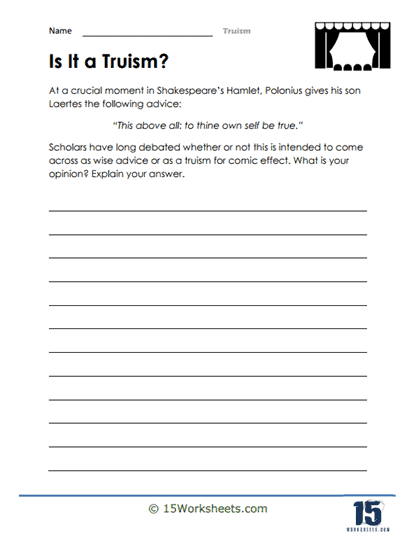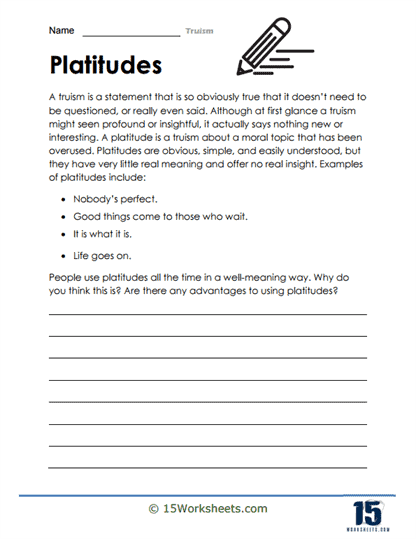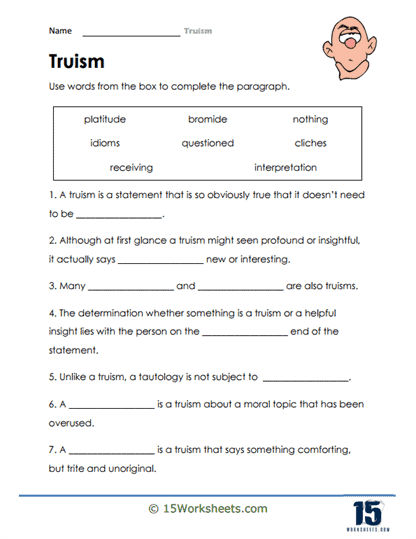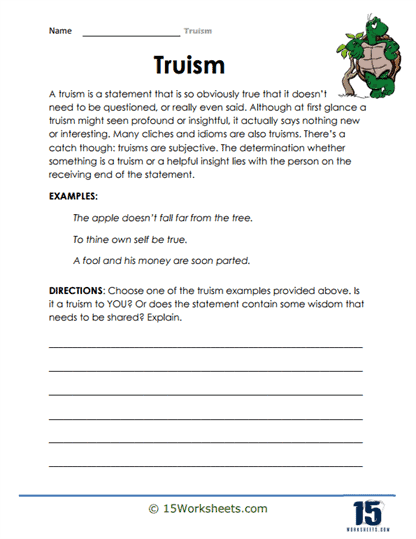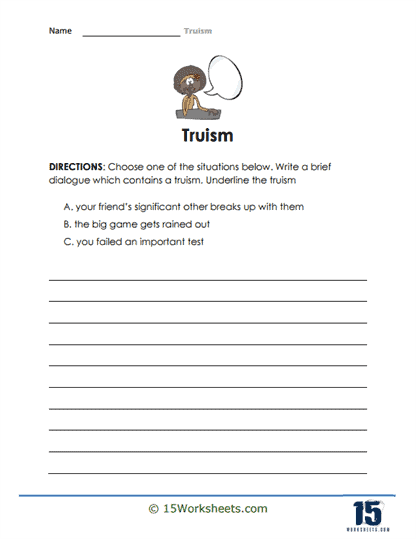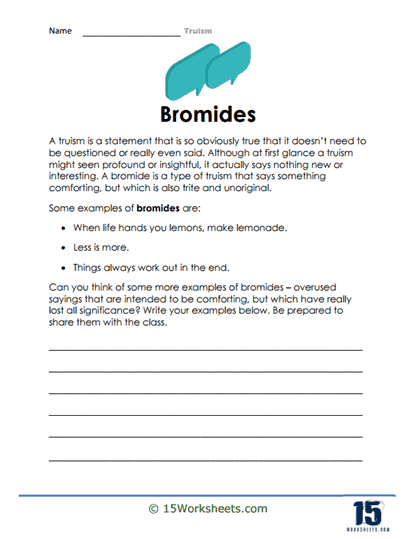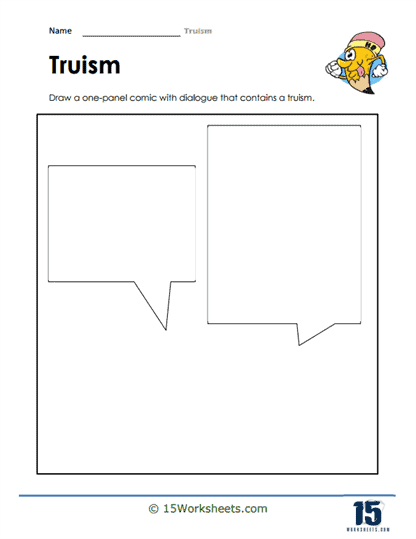Truism Worksheets
About These 15 Worksheets
Truism Worksheets are educational tools designed to enhance students’ understanding and use of language, focusing on common sayings or truths that are widely accepted without controversy. These worksheets incorporate a variety of exercises that challenge students to analyze, interpret, and create using these truisms as a foundation. Engaging with Truism Worksheets can significantly bolster students’ language arts and reading skills by developing critical thinking, comprehension, vocabulary, and creative writing abilities. This detailed exploration will cover the different types of exercises found in Truism Worksheets and how they facilitate learning in multiple aspects of language arts.
Through a variety of exercises, they promote deep comprehension, critical thinking, creative expression, and linguistic proficiency. By engaging with these worksheets, students not only improve their academic skills in language arts but also cultivate a lifelong appreciation for the nuances and power of language. Whether through the analysis of meaning, the creative crafting of narratives, or the exploration of language structure, Truism Worksheets equip students with the tools they need to navigate the complexities of language and literature with confidence and insight.
Types of Exercises
Interpretation and Analysis – These exercises require students to explore the meanings and implications of various truisms. Students might analyze a truism to discuss its applicability to different life situations, compare its meaning to their personal experiences, or debate its validity in a group discussion. This not only deepens their comprehension but also encourages them to critically engage with text, enhancing inferential thinking skills.
Contextual Application – Students use truisms to create or understand contexts. For example, they might be asked to write a short story or dialogue where a truism plays a central role, or identify the relevance of a truism within a provided scenario. This exercise strengthens their ability to apply abstract ideas to concrete situations, improving their analytical and creative thinking.
Vocabulary Building – Exercises might focus on the specific language used in truisms, encouraging students to explore synonyms, antonyms, or the etymology of key words. This not only expands their vocabulary but also deepens their understanding of the nuanced meanings of words and phrases, an essential skill for proficient reading and writing.
Creative Writing – These exercises prompt students to write narratives, poems, or arguments inspired by a truism. This practice fosters creativity, encourages students to express their thoughts clearly, and helps them understand how foundational truths can be woven into various forms of writing.
Comparative Analysis – Students may compare and contrast truisms, analyzing how different sayings convey similar or divergent meanings. This teaches them to identify themes and perspectives across texts, a skill critical for advanced reading comprehension and literary analysis.
Grammar and Sentence Structure – Some exercises focus on the grammatical construction of truisms. Students might reconstruct sentences to alter their meaning slightly or to use a different grammatical mood or voice, thereby deepening their understanding of how grammar influences meaning.
Benefits of These Worksheets
Enhanced Comprehension Skills – Working with truisms helps students to develop a deeper level of text comprehension. They learn to read between the lines, infer meanings, and connect concepts to their broader knowledge and experiences. This is essential for mastering more complex reading materials.
Improved Critical Thinking – The analysis of truisms encourages students to question and ponder the underlying truths in language. This fosters a habit of critical thinking, as students evaluate the validity, applicability, and implications of different statements.
Creative Expression and Writing Skills – By engaging in creative writing exercises based on truisms, students enhance their ability to express themselves in writing. They learn how to structure narratives, use descriptive language effectively, and convey complex ideas creatively.
Expanded Vocabulary and Language Use – Vocabulary exercises associated with truisms expose students to new words and phrases, broadening their language repertoire. This is crucial for improving both their understanding of reading materials and their ability to express themselves eloquently.
Improved Analytical Skills – Comparative and contextual application exercises sharpen students’ analytical abilities. They become adept at making connections between texts, identifying themes, and applying abstract ideas to real-world situations.
Grammar and Syntax Mastery – By dissecting and reconstructing the sentences found in truisms, students gain a stronger grasp of grammar and syntax. This knowledge is vital for both understanding complex texts and crafting clear, coherent writing.
What is the Literary Device of Truism?
The literary device of truism plays a significant role in the realm of writing, offering authors a unique tool to express universally accepted truths in a manner that resonates deeply with readers. A truism is a statement that is so self-evidently true that it requires no further proof, often reflecting on common human experiences or fundamental aspects of life. These statements can be simple or profound, but their main defining feature is their undeniable truth, which everyone can agree upon regardless of their personal beliefs or experiences.
The Defining Feature of a Truism
The main defining feature of a truism is its universal acceptance as truth. Unlike an argument or a hypothesis, a truism does not need to be defended, proven, or debated. It is a statement that is taken at face value for its inherent truthfulness, often reflecting on general facts about life, human nature, society, or the natural world.
Characteristics of a Truism
Universality – Truisms are universally acknowledged truths. They are not subjective but are accepted by a wide range of people across different cultures and societies.
Simplicity – While some truisms can be profound, they are typically expressed in simple terms, making them easily understandable to a broad audience.
Reflective of Common Experiences – Truisms often touch on common human experiences, emotions, and observations about life, making them relatable to a wide audience.
Non-controversial – Truisms are non-debatable statements that do not provoke controversy or disagreement, given their acceptance as truth.
Instructive Nature – Although not always intended as advice, truisms can offer insights or lessons about life and human behavior.
Examples of Truism in Literature and Their Effects
“All’s fair in love and war.” – This truism, often quoted in literature, suggests that in certain situations (like love or conflict), people are allowed to break the usual rules of behavior. It reflects on the extreme measures individuals might resort to when faced with the complexities of love or the chaos of war. This truism speaks to the universal understanding of the intensity and desperation that can accompany these human experiences. When used in literature, it prompts readers to reflect on their moral boundaries and the justifications for actions taken in the name of love or war, creating a deeper engagement with the narrative.
“Time waits for no one.” – Frequently appearing in both literature and everyday life, this truism emphasizes the relentless, unchangeable nature of time. It serves as a reminder of life’s impermanence and the urgency to make the most out of every moment. Authors may use this truism to highlight a character’s realization about missed opportunities, the importance of seizing the moment, or the inevitability of change. For the reader, it reinforces the value of time and prompts introspection about how one’s time is being spent, often evoking a sense of urgency or nostalgia.
“You can’t judge a book by its cover.” – This well-known truism is used to convey the idea that appearances can be deceiving and that deeper understanding requires looking beyond the surface. In literature, this truism can be used to set up character development arcs, plot twists, or to challenge societal norms and prejudices. It encourages readers to question their preconceptions and look deeper into the motives, personalities, and truths of the characters and situations presented. The effect on the reader is a more nuanced understanding of the complexity of human nature and the importance of empathy and open-mindedness.
Why Authors Use Truism in Their Writing
Authors use truism in their writing for several reasons:
To Connect with the Reader – Truisms are relatable. By incorporating them into their writing, authors create a connection with the reader through shared truths about human experiences.
To Convey Themes – Truisms can succinctly express the themes of a work, offering insights into the universal truths that the author wishes to explore.
To Enhance Character Development – Characters who reflect on or express truisms can appear more introspective, wise, or realistic, adding depth to their portrayal.
To Prompt Reflection – By including truisms, authors encourage readers to reflect on the larger truths of life, often leading to a more engaged and thoughtful reading experience.
To Add Realism – Using truisms can lend authenticity to the narrative, making the fictional world more relatable and believable.




